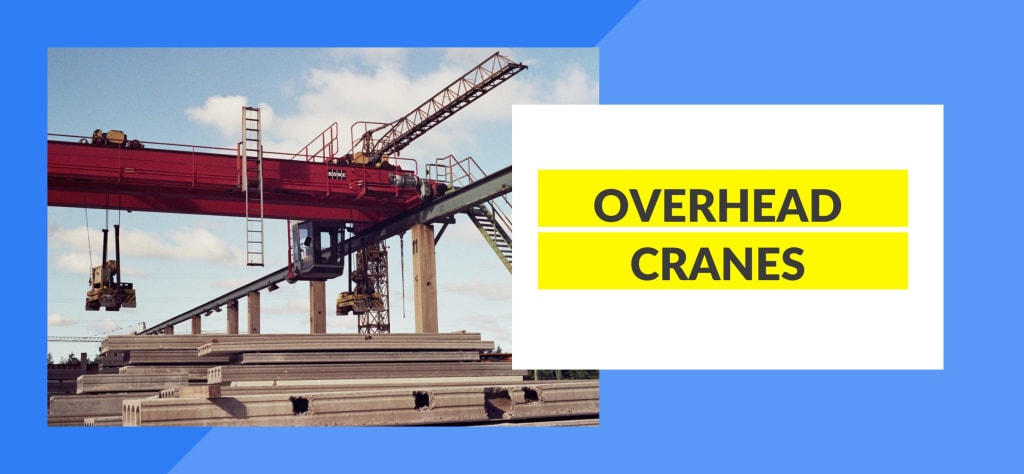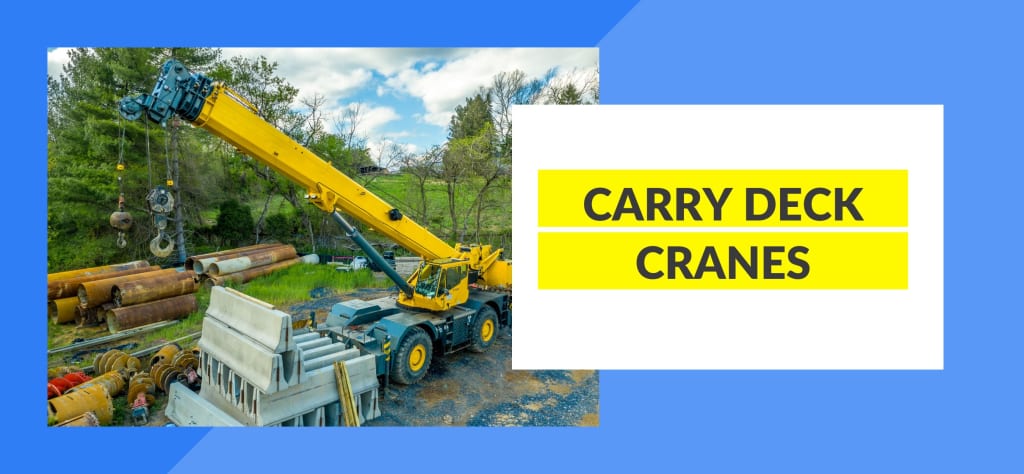Last Updated on June 16, 2022
What are the different types of cranes? These tall machines come in different shapes, and employ different design engineering and physics to lift loads. Although high-tower construction is probably the most iconic crane, these machines get used in various ways. Applications include manufacturing, pick-and-carry, rail yards, forestry, and sunken ship retrieval.
On construction sites, cranes are often rented, sometimes for years. All of them can be divided into two main categories: stationary and mobile.
Stationary
Stationary cranes can be subcategorized into two definite types: tower and overhead.

Tower cranes
Tower cranes are one of the more visible cranes. They’re large – even taller than the buildings they are helping to erect – and they sit in one spot for months or years before getting torn down and assembled at a new site.
An engineer is required to draft a tower crane’s erection plan. This includes designing the platform to which the crane will be anchored, and once fully assembled (but before initial use), determine whether the structure is safe.
All tower cranes feature a mast (also called a tower) and a jib (a boom). Since they have a jib, people sometimes refer to them as jib cranes, although jib cranes are a type of overhead crane (more on that below).
There are several different types of tower cranes: hammerhead, A-frame, flat-top, luffing tower, and self-erecting.
Hammerhead Tower Cranes
Hammerhead tower cranes can be easily recognized by their lopsided capital letter “T” appearance. They are especially reliable for precise, accurate handling of a wide variety of heavy materials. Their loads include concrete and steel. Hammerhead tower cranes offer precise horizontal movement of the load, since the jib always remains at the same elevation. This is known as racking.
A-Frame Cranes
A-frame cranes have a structure over the cab that connects the jib to the counter jib. The counter jib is the part of the crane that overhangs the tower opposite to the lifting side. It is the counterbalance that allows for heavier lifts.
Flat-top Cranes
Flat-top cranes have no structure over the cab. This allows for working in environments with low head-room or where multiple cranes may move loads in each other’s lift paths. These machines can’t carry as much as A-frames.
Luffing Tower Cranes
A luffing tower crane (or luffing jib crane) can raise its jib. This machine doesn’t use a trolley to move the load toward or away from the tower. Instead, it raises the boom drawbridge-style, which decreases the distance between the load and the tower. By moving a load closer to the tower, the load also gets elevated. These types of cranes can lift heavier weights. And due to their short slew radius, they can work on sites with multiple cranes with little risk of overlapping lift paths.
Self-Erecting Cranes
Self-erecting cranes refer to cranes that don’t require the aid of another crane to assemble them. That’s how all the previously mentioned cranes are assembled. One type of self-erecting crane is also known as a telescopic crane, because the mast telescopes up through the use of hydraulic pressure. The other type of self-erecting crane is one that never gets dismantled. It’s designed to be transported by truck in one piece and then erected on site. Sizes and lift capacities for self-erecting cranes are limited.

Overhead cranes
Many overhead cranes are bridge cranes, so the terms are often used interchangeably, however, there are five subcategories of overhead cranes: bridge, gantry, monorail, jib, and workstation.
Bridge cranes feature two rails (often fastened to the walls of a building, such as a manufacturing facility or steel mill) and one or two girders that bridge the two rails. The hook (or other lifting mechanism) is fastened to a trolley capable of moving across the girders (bridge). The bridge can also move along the rails. Top running bridge cranes can lift more weight but rely on columns to support the rails. Bottom running bridge cranes hang from the ceiling, which saves floor space, but they can’t lift as much weight.
Gantry cranes are similar to bridge cranes, except their rails aren’t fixed to another structure or to columns that are fixed to the floor. The rails are supported by columns that are connected to a rail system, tracks or wheels. They are often used outdoors, such as a rail yard or shipyard, since there is no building to which the crane can be fastened. Gantry cranes can be either portable (wheels), track-mounted (tracks) or engineered (rail).
Monorail cranes allow for movement of material on only one plane. They move side to side but not forward and backward. These machines are great for assembly and production lines.
Jib cranes can be mounted to either a column that is part of a building’s structure or it can have its own column. This type operates similar to a tower crane. Its jib can rotate either 180 degrees or 360 degrees depending on configuration.
Workstation cranes are small overhead cranes with low lift capacities. They can be ceiling hung or free standing and are designed to help the user ergonomically move an item. They are sometimes referred to as hoists.

Floating cranes
A floating crane is a crane that is fastened to a platform that can float and may or may not be motorized. They are ideal for offshore construction, including drilling rigs and shipbuilding. Floating cranes are also used in the retrieval of large items that have sunk.
Floating cranes are fixed in place and use the same lift and design engineering as tower cranes (hammerhead, luffing jib, etc.). For that reason they share several qualities with tower cranes. It does not have tires or tracks, yet it is mobile, sometimes by its own power. So, is it a stationary crane or a mobile crane?
Answering that question requires knowing more about mobile cranes.
Mobile cranes
Mobile cranes are less expensive than fixed cranes and don’t require an engineer to set up. They can also lift more than tower cranes when scaled for size.
They feature either a telescopic boom (jib), which means the boom telescopes out to reach higher and farther, or a lattice jib. The above tower cranes feature a lattice boom jib. Lattice refers to the honeysuckle/mesh-like pattern of the jib.

Carry deck cranes
These are considered pick-and-carry machines. They pick up an item at one place and transport it to another place. They traditionally don’t have much reach and they don’t get used to erect anything. Their purpose is similar to a forklift, but the manner in which they lift is drastically different.
The machine features a low, flat profile structure with a telescopic crane. Four stabilizers help the machine when lifting heavy loads from a stationary position. One pair is in front of the front wheels and one pair behind the rear wheels.

Crawler cranes
A crawler crane is a mobile crane that comes equipped with tracks instead of wheels. The tracks decrease the crane’s ground pressure while improving traction. These are ideal for applications that require extreme terminability, high grades. or low ground pressure. Some lifts are heavy, and the combined weight of the load plus the crane can be too much weight for the underlying surface to bear.

Truck-mounted cranes
A truck-mounted crane is the most mobile of all the cranes. It has the fastest travel speeds and makes the most comfortable ride. The machine rides like a truck and the crane is built on the truck chassis. The truck manufacturer is responsible for building this chassis. Conversely, the crane is often the product of a collaboration between the crane manufacturer and truck manufacturer, but not always. Sometimes, the crane manufacturer is just a customer of the truck manufacturer. The crane manufacturer builds the crane body onto a truck that previously had no body.

Rough terrain cranes
A rough terrain crane is just a mobile crane that has been built for off-road and even difficult terrain.
Features that make it more suitable for rough terrains include a higher ground clearance, different drive options, rough terrain wheels, and more durable parts.

All-terrain cranes
All-terrain cranes get their name for the same reason all-terrain tires get their name. They are designed to work in all sorts of landscapes, unlike other crane types.
These machines are not specialists. They usually don’t operate best in any terrain, but they have the features needed to work well in various terrains.

Loader cranes
Loader cranes are fastened to the body of a truck. Unlike truck cranes, which have a cab for operating the truck and a separate cab for operating the crane, loader cranes come with only a truck cab. The crane is operated either from controls at the base of the station or via remote control. The truck’s bed is long and flat – perfect for pallets, long building materials, and logs. The sole purpose of the crane is to load and unload materials onto the truck bed often using either a fork or grapple attachment. This application makes loader cranes unique from all other mobile cranes.
There we have it, many different types of cranes. And we return to the question – does the floating crane fit in the mobile and stationary categories?
Although it shares a lot of features with tower cranes, such as the jib and lift engineering, it is a mobile unit that requires little-to-no setup. Maybe mobile is probably the more accurate category.
In the end, the floating crane and all other cranes are diverse lift machines whose applications are only limited by imagination. They along with other forms of heavy equipment get used on projects big and small. Whether you’re working on something for your local community, or a governmental worksite, Municibid has options for you.
